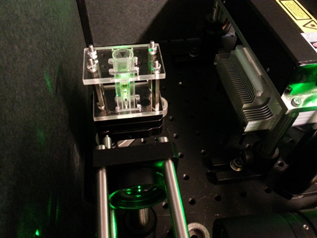Time-resolved singlet-oxygen luminescence
detection with an efficient and practical
semiconductor single-photon detector
Gianluca Boso, Damei Ke, Boris Korzh, Jordan Bouilloux, Norbert Lange and
Hugo Zbinden
Biomedical Optics Express, 7, 211 (2016)
Photodynamic therapy (PDT) is a recent technique that can help the treatment of various medical conditions, from skin and prostate cancer to certain bacterial infection. In our recent paper on Biomedical Optics Express we demonstrated that using a practical and efficient InGaAs/InP single-photon detector we developed, we are able to detect the faint luminescence signal ( at 1270 nm) from the decay of singlet-oxygen, the active molecule involved in PDT. This helped quantify the amount of singlet-oxygen produced by new photosensitive drugs developed at the University of Geneva. The technique will also help to better understand the mechanisms of singlet-oxygen in PDT both in-vitro and in-vivo.

Experimental setup used to detect the singlet-oxygen luminescence signal
produced in different aqueous solutions of photosensitiser. The sample is excited with a 532
nm pulsed laser and the luminescence signal is collected through a confocal scheme.